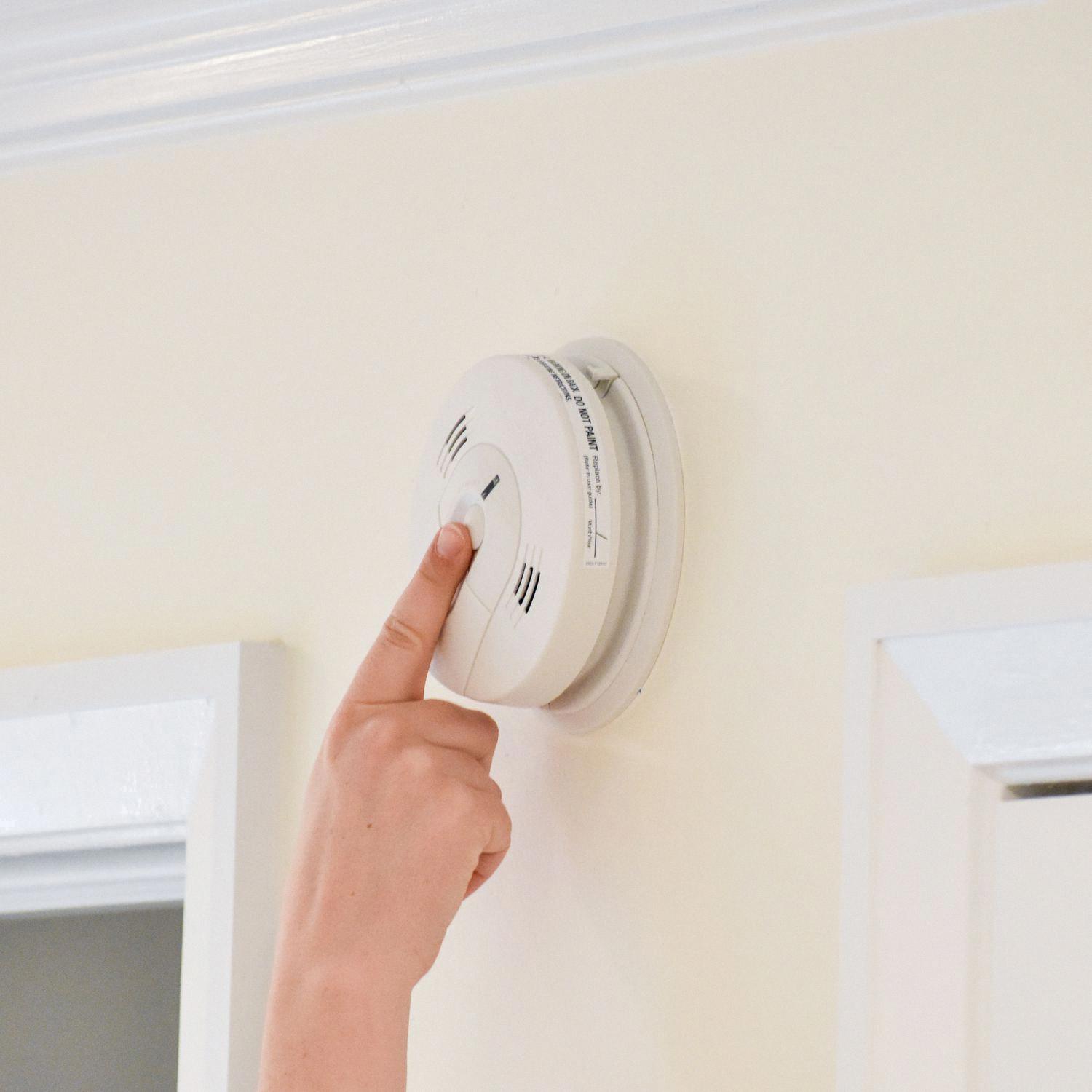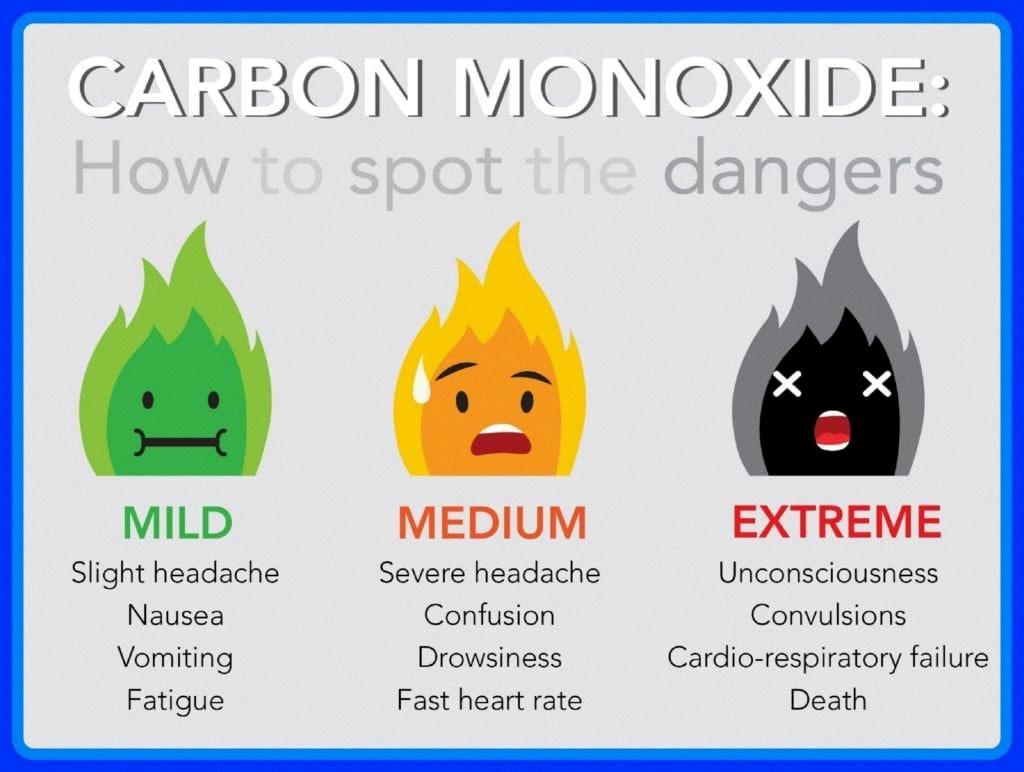Carbon monoxide is a toxic gas that can be deadly if inhaled in high concentrations. It is often referred to as the “silent killer” because it is odorless and colorless, making it difficult to detect without a carbon monoxide detector. One common misconception about carbon monoxide is whether it rises or sinks. Let’s take a closer look at this question.
Firstly, it is important to understand that carbon monoxide is slightly lighter than air, but not enough to rise to the ceiling in a room. Instead, it tends to disperse itself, mixing with the air and spreading throughout a space. This means that carbon monoxide can be present at any level in a room, regardless of whether it is near the floor or ceiling.
The reason why carbon monoxide doesn’t rise or sink like other gases, such as natural gas or propane, is due to its molecular weight. Carbon monoxide molecules are made up of one carbon atom and one oxygen atom, giving it a molecular weight of 28 g/mol. This is similar to the molecular weight of air, which is around 29 g/mol. As a result, carbon monoxide can mix easily with the air inside a room and doesn’t behave like other gases that are heavier or lighter than air.
Another important factor to consider is that carbon monoxide can easily travel through drywall and other materials. This means that even if a fuel-burning appliance is located in another room, carbon monoxide can still seep through walls and into other areas of the home. This is why it is important to have carbon monoxide detectors installed on each level of your home, as well as near any potential sources of carbon monoxide, such as a furnace or water heater.
While carbon monoxide is slightly lighter than air, it doesn’t rise or sink in the same way that other gases do. Instead, it tends to disperse itself and mix with the air in a room. This makes it important to have carbon monoxide detectors installed throughout your home to ensure that you are alerted to any dangerous levels of this toxic gas. Remember, when it comes to carbon monoxide, it’s alays better to be safe than sorry.
Does Carbon Monoxide Move Upward?
Carbon monoxide is a gas that is slightly lighter than air, which means that it does not rise to the ceiling in a room. Instead, it tends to disperse itself by mixing with the air and spreading throughout a space. Due to its odorless, colorless, and tasteless nature, it can be difficult to detect, making it a potentially deadly gas if not properly monitored. It is important to have carbon monoxide detectors installed in living spaces to ensure the safety of individuals within the area.

Source: thespruce.com
Rising Rate of Carbon Monoxide
Carbon monoxide is a colorless and odorless gas that is produced by incomplete combustion of fossil fuels. It is a dangerous gas that can cause serious health problems and can even be fatal in high concentrations. The speed at which carbon monoxide rises depends on various factors, such as the source of the gas, the ventilation in the area, and the surrounding temperature.
In general, carbon monoxide is slightly lighter than air, so it tends to rise in the presence of warmer air. However, this movement can be slow, and the gas can spread throughout a room or a building without being properly ventilated. Additionally, carbon monoxide can be carried by air currents and can travel through vents and ducts, which can cause it to spread quickly throughout a building.
The speed at which carbon monoxide rises can also depend on the concentration of the gas. At low concentrations, it can take several hours for the gas to become noticeable. However, at higher concentrations, it can take only a few minutes for the gas to reach dangerous levels that can cause symptoms such as headache, dizziness, nausea, and even death.
It is important to note that carbon monoxide alarms can detect the presence of the gas befre it reaches dangerous concentrations. These alarms can provide an early warning and give people the opportunity to evacuate the area and seek medical attention if necessary. Therefore, it is essential to have carbon monoxide alarms installed in your home and to test them regularly to ensure they are working correctly.
Placement of Carbon Monoxide Detectors
When it comes to placing a carbon monoxide detector, there are a few important things to keep in mind. First and foremost, it’s important to have at leat one CO alarm on each level of your home, including the basement and attic. This ensures that you’ll be alerted to any potential carbon monoxide leaks no matter where they occur in your home.
In addition, it’s a good idea to place CO detectors near any fuel-burning appliances in your home, such as your furnace, water heater, or fireplace. This is because these appliances can potentially emit carbon monoxide, so having a detector nearby can alert you to any leaks.
It’s also recommended to place CO detectors outside of sleeping areas, so that you can be alerted to any potential leaks while you’re sleeping. And if you have a garage attached to your home, it’s a good idea to place a CO detector near the door to the garage, since cars and other vehicles can also emit carbon monoxide.
It’s better to err on the side of caution when it comes to placing carbon monoxide detectors in your home. By having multiple detectors in strategic locations throughout your home, you can help ensure that you and your family are alerted to any potential carbon monoxide leaks as quickly as possible.
Does Carbon Monoxide Increase with Hot Air?
Carbon monoxide does not rise like hot air. Unlike hot air, which is less dense and lighter than the surrounding cold air, carbon monoxide has a similar density to air, which means it doesn’t rise or sink. Instead, it mixes easily with the air inside a home, which makes it extremely dangerous because it can spread quickly and evenly throughout a space, posing a significant risk of poisoning to anyone in the area. It’s important to note that carbon monoxide is an odorless gas, which means that without an alarm to notify you that it is present, you may not be aware of its existence until it’s too late. Therefore, it’s crucial to have carbon monoxide detectors installed in your home to protect yourself and your family from its harmful effects.
The Effects of Carbon Monoxide on Air Quality
Carbon monoxide (CO) is a colorless, odorless, and tasteless gas that is slightly lighter than air. This means that it does not rise or sit low but rather it diffuses evenly throughout the room. Therefore, the myth that carbon monoxide alarms should be installed lower on the wall because carbon monoxide is heavier than air is incorrect. In fact, carbon monoxide can be found at any height within a room or enclosed space, and it can quickly spread throughout a building, making it important to have carbon monoxide alarms installed in multiple locations. It is recommended to install carbon monoxide alarms on every floor of your home, including outside each sleeping area and in basements or oher enclosed spaces where carbon monoxide can accumulate. This will help ensure that you and your family are alerted to the presence of carbon monoxide in your home and can take immediate action to protect yourselves from the potentially deadly effects of this gas.

Source: kplctv.com
Signs of Carbon Monoxide in the Home
Carbon monoxide is a colorless, odorless gas that can be very dangerous if it builds up in your home. Fortunately, tere are several signs that can indicate the presence of carbon monoxide. If you notice any of these signs, it is important to take action right away to protect yourself and your family.
One of the most obvious signs of carbon monoxide is yellow or orange flames coming out of your gas appliances instead of the usual blue flame. This can indicate that the fuel is not burning properly, which can lead to the production of carbon monoxide. You may also notice dark and sooty staining on or around gas appliances, which can be another indication of incomplete combustion.
Another sign of carbon monoxide is pilot lights that frequently blow out. This can occur when there is not enough oxygen for the flame to burn properly, which can lead to the production of carbon monoxide. You may also notice increased condensation on windows, which can be caused by the buildup of moisture from incomplete combustion.
If you have solid fuel fires in your home, you may notice that they burn much slower than usual. This can be a sign that there is not enough oxygen for the fire to burn properly, which can lead to the production of carbon monoxide.
If you notice any of these signs in your home, it is important to take action right away. You should open windows and doors to allow fresh air to circulate, and you should turn off any gas appliances that may be producing carbon monoxide. If you suspect that there is a serious problem, you should evacuate your home and call emergency services right away. Remember, carbon monoxide can be very dangerous, so it is important to be aware of the signs and take action to protect yourself and your family.
Warning Signs of Carbon Monoxide Poisoning
Two common warning signs of carbon monoxide poisoning are headache and dizziness. Headache is often the first symptom to appear, and it can be mild or severe. Dizziness can also occur, and it may be accompanied by nausea or vomiting. Other symptoms of carbon monoxide poisoning may include weakness, confusion, chest pain, and shortness of breath. It is important to note that carbon monoxide is a colorless, odorless gas, so it is difficult to detect wihout a carbon monoxide detector. If you suspect that you or someone else may be experiencing carbon monoxide poisoning, it is crucial to seek medical attention immediately and evacuate the affected area.
Can Opening a Window Prevent Carbon Monoxide Poisoning?
Simply opening windows cannot effectively prevent carbon monoxide poisoning. Carbon monoxide (CO) is a colorless, odorless, and tasteless gas, whih makes it difficult to detect. When inhaled in high concentrations, it can cause severe health problems, including loss of consciousness and even death.
While opening windows can improve ventilation, it is not enough to eliminate the risk of carbon monoxide poisoning. The best way to prevent CO poisoning is to install and maintain CO detectors in your home. These detectors can sound an alarm when they detect high levels of CO in the air, giving people in the area enough time to evacuate safely.
Additionally, it is essential to ensure that all fuel-burning appliances in your home, including gas stoves, furnaces, and water heaters, are properly maintained and serviced regularly by a qualified technician. Adequate ventilation of these appliances is also crucial to prevent CO buildup.
While opening a window can help improve ventilation, it is not a reliable method for preventing carbon monoxide poisoning. Installing and maintaining CO detectors and properly maintaining fuel-burning appliances are the most effective ways to prevent CO poisoning.
Can Carbon Monoxide Detectors Falsely Activate?
A carbon monoxide (CO) detector can go off for no reason. This is known as a false or nuisance alarm. There are several reasons why this can happen. One common cause is a malfunctioning detector. If the detector is old or damaged, it may produce false alarms. Another reason is interference from other electronic devices. This can include cell phones, radios, or other electronic devices that emit electromagnetic waves. environmental factors such as humidity, temperature, or even dust can trigger a false alarm. It’s important to remember that even though false alarms can be frustrating, it’s better to err on the side of caution and take all alarms seriously. If your CO detector goes off, it’s important to evacuate your home immediately and call emergency services.

Source: arctichc.com
Carbon Monoxide Detector Trigger Level
The level at which a carbon monoxide detector is triggered depends on the concentration of carbon monoxide in the air. Generally speaking, a low level of CO (50 parts per million or less) may take up to eight hours for the detector to go off. However, higher levels of CO (over 150 parts per million) can trigger the alarm within minutes. It’s important to note that even low levels of carbon monoxide can be dangerous over time, so it’s crucial to have a working carbon monoxide detector in your home to alert you to any potential dangers.
Signs of Carbon Monoxide Poisoning Without a Detector
It is important to note that carbon monoxide (CO) is a colorless and odorless gas, which makes it difficult to detect wihout a detector. However, there are some signs that could indicate a potential CO leak.
One way to tell if there is carbon monoxide without a detector is to look for brownish or yellowish stains around appliances. These stains can be caused by the buildup of soot that can occur due to incomplete combustion.
Another sign is a pilot light that frequently goes out, as this could indicate that there is not enough oxygen for complete combustion, which can produce CO.
If you notice a burner flame that appears yellow instead of clear blue (with the exception of natural gas fireplaces), this could also be a sign of incomplete combustion that could produce CO.
A chimney flue that lacks an upward draft could also indicate a CO leak. This is because a draft is necessary to carry the harmful gas away from your home.
If you notice stale-smelling air or experience symptoms such as headaches, nausea, or dizziness, it is essential to take immediate action, as these could be signs of a CO leak. If you suspect a CO leak, it is critical to evacuate your home immediately and seek medical attention.
Level of Carbon Monoxide Required to Set Off a Detector
Carbon monoxide detectors are designed to detect the presence of carbon monoxide gas in the air and trigger an alarm to warn people of potential danger. The level of carbon monoxide that sets off a detector depends on the sensitivity of the device and the duration of exposure. The UL standard for carbon monoxide detectors requires them to alarm wihin 90 minutes when exposed to 100 parts per million (ppm) of CO, 35 minutes when exposed to 200 ppm, and 15 minutes when exposed to 400 ppm. However, some detectors are more sensitive and may detect or alarm at lower levels if exposed for an extended period of time. It’s important to note that low-level exposure to carbon monoxide can still be harmful to human health, and it’s recommended to have a detector installed in every sleeping area and on every level of a home to ensure maximum safety.
The Dangers of Carbon Monoxide in the Home
You should definitely be concerned about the presence of carbon monoxide in your house. Carbon monoxide is a by-product of combustion, which means it can be produced by any appliance that burns fuel, such as gas stoves, furnaces, or water heaters. Even small amounts of carbon monoxide can be dangerous, as it can lead to symptoms such as nausea, dizziness, or headaches. In severe cases, carbon monoxide poisoning can cause brain or heart damage or even death.
The good news is that there are steps you can take to protect yourself and your family from the dangers of carbon monoxide. First and foremost, it’s important to have working carbon monoxide detectors installed in your home. These devices can alert you to the presence of carbon monoxide before it reaches dangerous levels. It’s also a good idea to have your appliances checked regularly by a qualified professional to ensure they are functioning properly and not producing excessive amounts of carbon monoxide.
In short, while carbon monoxide is a common hazard in the home, there are simple steps you can take to minimize the risks and keep yourself and your family safe. Don’t hesitate to take action to protect your home and your loved ones from this potential danger.

The Duration of Carbon Monoxide in the Air
Carbon monoxide is a colorless, odorless gas that is produced by the incomplete combustion of fossil fuels. When released into the environment, it can linger in the air for an average of abut 2 months. During this time, carbon monoxide can react with other compounds in the atmosphere, and it may also be converted to carbon dioxide by microorganisms found in soil and water. Ultimately, carbon monoxide will be removed from the air through these processes, and its effects on air quality and human health will diminish. It’s important to note, however, that exposure to carbon monoxide can have serious health consequences, and it’s essential to take preventative measures to ensure that levels of this gas remain within safe limits.
Ignition Temperature of Carbon Monoxide
The autoignition temperature of carbon monoxide is 1148˚F (620˚C). This means that carbon monoxide will spontaneously ignite at this temperature without the need for an external ignition source. It is important to note that carbon monoxide is typically stored and transported in high-pressure cylinders, tube trailers, or ISO modules depending on the quantity required by the consumer to ensure safe handling and prevent accidental ignition.
Conclusion
Carbon monoxide is a gas that does not rise or sink, but instead mixes easily with the air present in a room. Its small molecules can easily pass through drywall, making it a dangerous gas that can spread quickly throughout a home. As it is odorless, it is important to install CO alarms on every level of a home, especially near fuel-burning appliances and outside sleeping areas. By taking these necessary precautions, we can help prevent the harmful effects of carbon monoxide and ensure the safety of our homes and loved ones.
